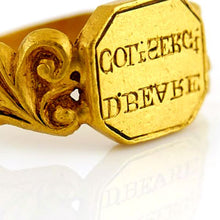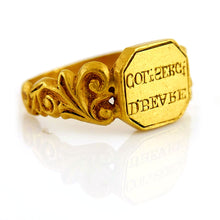Colour Sergeant’s Beare’s Indian Gold Ring, 1857
Adding product to your cart
Size: T
Indian gold signet ring, the shank worked with scrolling foliage to the shoulders, the rectangular table with canted corners and inscribed in reverse ‘D. BEARE COLr SERGt’.
Colour Sergeant Daniel Beare, HM’s 53rd (Shropshire) Regiment, was born in Farnborough, Surrey in 1823. He enlisted in the 39th (Dorsetshire) Regiment and sailed for India with a draft of recruits. The 39th left India two years later after 13 years service in the country whence Beares transferred into the 53rd which had arrived in 1844. Thenceforth Beare was destined to soldier in India for the next fifteen years, seeing action in the First Sikh War (1845-46) at the battles of Aliwal (1846) and Sabroan (1846), and in the Second Sikh War at the decisive Battle of Gujerat (1849). While stationed at Fort William (Kolkata), Beare married Margaret Hough (1839-1884) on 27 June 1854. Promoted Corporal, Beare served with the 53rd in an 1852 punitive expedition under Brigadier-General Sir Colin Campbell against the Ranizais in Turrangai on the North West Frontier for which he and other members of the regiment were erroneously awarded the India General Service Medal (1854-95) after a clasp was authorized in 1869.
Read more
When the Indian Mutiny broke out in May 1857, the 53rd was one of the few British regiments immediately available to suppress the insurrection. It was often deployed in detachments or ‘wings’ and served in its traditional light infantry role. The fighting was brutal and little quarter given or expected on either side. It was probably under these circu,stances that Beare indulged in the frequent looting of native property and acquired the present ring.
In March 1858 Beare took part in the capture of Lucknow as part of a force of 31,000 men under Sir Colin Campbell. Positions that had been assaulted the previous November during the relief of the Lucknow garrison were reoccupied and the Begum Kothi complex of palace buildings in the north of the city was systematically destroyed. The 53rd Foot attacked rebel defence works along the banks of the river Goomtee and occupied them one by one. The assaults continued for three weeks until the fighting ended on 21 March 1858, with British losses of 129 killed and 595 wounded. The 53rd Foot lost 30 killed and wounded.
Beare returned to Devonport with the regiment in 1861 and after serving at the regimental depot was retired to pension on 17 March 1863. (Royal Hospital Chelsea Admission Books. Registers and Papers, 1702-1980). For the rest of the decade he was the landlord of the White Hart, at Tongham in Surrey, and at the 1871 census declared his as occupation ‘Publican / Chelsea Pensioner’. In the 1870’s he continued as pub landlord but also became a grocer and tea dealer.
His nephew succeeded him at the white Hart but he continued living at the inn into the 1890s. He died at Hartley Witney in 1894 and was buried in the churchyard of at St Peter, Farnborough, Surrey.








